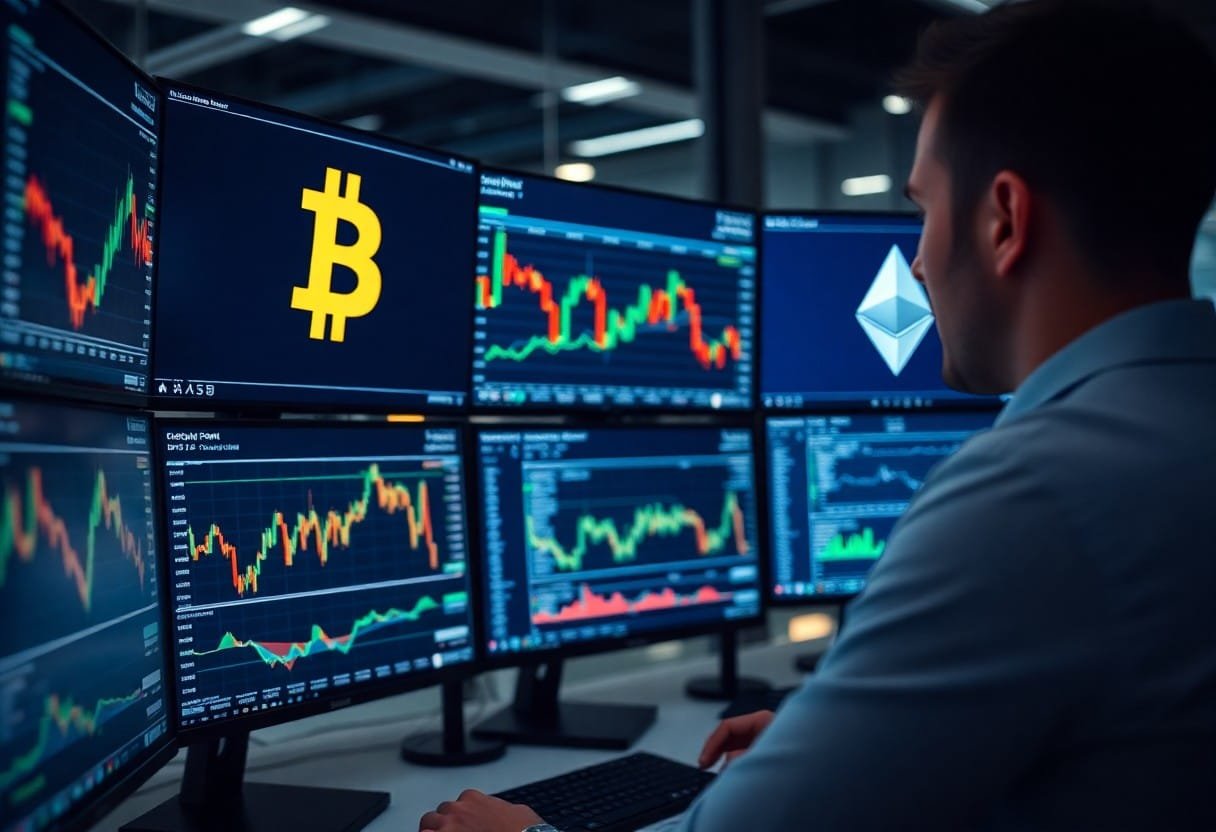You may find yourself questioning what lies ahead for altcoins in the ever-evolving cryptocurrency landscape. As market dynamics shift and technological advancements emerge, understanding the trends shaping altcoins will be imperative for making informed investment decisions. In this blog post, you’ll discover key trends to watch, including regulatory developments, adoption rates, and innovative projects that could influence the future of altcoins. By staying informed, you can navigate this exciting space with confidence and seize potential opportunities that come your way.
Key Takeaways:
- Innovation in DeFi: The rise of decentralized finance (DeFi) continues to drive new altcoin projects, offering innovative financial solutions and attracting user interest.
- Regulatory Developments: Expect increased scrutiny and regulation around altcoins, impacting their adoption and market dynamics.
- Interoperability Focus: Greater emphasis on cross-chain capabilities will enhance altcoin utility, allowing for smoother transactions across different blockchain networks.
The Rise of Altcoins
While Bitcoin remains the dominant player in the cryptocurrency landscape, the rise of altcoins has significantly transformed your options for investment and technology. Altcoins, or alternative cryptocurrencies, have surged in popularity, driven by innovation and diverse use cases that cater to an expanding range of interests within the blockchain space.
Historical Context
By exploring the origins of altcoins, you can better appreciate how they have evolved since Bitcoin’s inception in 2009. Initially created to address limitations within Bitcoin, the first altcoins in the market offered distinct improvements, such as faster transactions or enhanced anonymity, leading to a vibrant ecosystem that has grown exponentially over the years.
Market Adoption
An increasing number of businesses and individuals are embracing altcoins, significantly impacting their market adoption. You may notice that various platforms are starting to accept altcoins for transactions, and investment opportunities continue to diversify. As blockchain technology matures and awareness grows, altcoins are gaining traction beyond the speculative investments of the past.
Another factor fueling market adoption is altcoins’ ability to cater to specific niches. For instance, some altcoins target decentralized finance (DeFi), while others focus on non-fungible tokens (NFTs) or smart contract functionality. This expansion into specialized applications allows you to engage with projects that align with your interests and investment strategy, ultimately driving up demand and the overall acceptance of altcoins in the broader cryptocurrency landscape.
Key Trends Shaping the Altcoin Landscape
One of the most significant trends influencing the altcoin market today is the growing intersection between traditional finance and the innovative world of decentralized finance (DeFi). As DeFi protocols gain traction, they not only improve liquidity and provide new revenue streams but also encourage the development and utility of various altcoins. Keeping an eye on these advancements will enable you to make more informed investment decisions and spot emerging opportunities.
DeFi and its Influence
By embracing decentralized finance, you open yourself to innovative financial services that utilize altcoins for lending, borrowing, and earning interest in a trustless manner. This shift is transforming how you approach financial transactions and investments, as DeFi enhances the overall utility and demand for altcoins in the market.
NFTs and Altcoin Integration
NFTs have captured your imagination with their unique, digital ownership capabilities, and their integration with altcoins is creating innovative ecosystems. By combining NFT technology with various altcoins, you can explore new ways to invest, trade, and engage with digital assets beyond mere speculation.
For instance, platforms that allow you to purchase NFTs using altcoins enhance the overall usability of these digital currencies, providing you with more options for investment and participation in the expanding digital art and collectibles market. This synergy broadens the appeal of altcoins, drawing in a diverse audience looking to merge traditional artistic expressions with modern investment opportunities.
Regulatory Developments
Not all altcoins will thrive equally as regulatory frameworks evolve. Keeping an eye on the latest legal changes is vital for your altcoin strategies. You can dive deeper into the nuances of these developments by checking Is crypto ‘altseason’ coming? Watch these 3 key signals in …. Understanding these shifts will help you navigate the complexities of altcoin investments in the years to come.
Global Regulatory Trends
Regulatory changes on a global scale impact your investment landscape significantly. Countries are increasingly focusing on establishing clear frameworks for cryptocurrencies, signaling a shift towards greater legitimacy. This evolving environment can either bolster confidence in altcoins or stifle innovation, depending on how regulations are crafted and implemented. As an investor, staying informed about these trends will be necessary for making strategic decisions in the altcoin market.
Impact on Altcoin Investments
After understanding the regulatory dynamics, it’s clear that they directly influence your altcoin investment strategies. Stricter regulations may lead to increased compliance costs for altcoin projects, potentially stalling their growth. However, positive regulatory developments can pave the way for broader adoption and investment, making it necessary for you to adapt your strategies accordingly. This volatility means that staying updated is key to optimizing your altcoin portfolio.
Another necessary aspect to consider is how regulations may impose limitations on certain tokens, impacting their liquidity and market accessibility. By understanding these regulations, you can make informed choices about which altcoins to invest in and when to enter or exit the market. Your ability to adapt to these regulatory changes will position you advantageously in the evolving cryptocurrency landscape.
Technological Innovations
Keep an eye on technological innovations as they continue to shape the future of altcoins. Emerging advancements in blockchain technology and decentralized applications are making altcoins more robust and appealing for developers and investors alike. You will want to stay informed about these innovations, as they could signify the next wave of successful cryptocurrencies in the market.
Blockchain Upgrades
On the horizon, various blockchain upgrades promise to enhance security, scalability, and efficiency across different altcoin platforms. As these upgrades are implemented, you may experience faster transaction times and lower fees, making altcoins more competitive with traditional financial systems.
Interoperability Enhancements
Interoperability is set to redefine how you interact with multiple blockchains. The enhancement of cross-chain communication allows for seamless transactions and data sharing between different altcoins, making it easier for you to navigate the diverse ecosystem. This could streamline processes and open new avenues for investment and utility.
Blockchain interoperability not only improves your ability to transact across multiple platforms, but also fosters collaboration between developers and projects. By breaking down silos, it creates a more inclusive environment where you can leverage the strengths of various altcoins. As this technology evolves, expect to see a surge in dApps and services that capitalize on these interconnected systems, enhancing your overall experience in the cryptocurrency space.
Market Sentiment and Community Influence
Many factors contribute to the market sentiment surrounding altcoins, including regulatory developments, technological advancements, and overall investor behavior. However, the influence of community sentiment cannot be overstated. Active communities play a significant role in shaping the perception and momentum of various altcoins, driving enthusiasm and participation. As you navigate this landscape, staying attuned to community discussions and trends will be necessary for making informed investment decisions.
Role of Social Media
After the rise of digital communication platforms, social media has become a powerful tool in shaping market sentiment. Platforms like Twitter and Reddit allow you to engage directly with project teams and fellow investors. This constant interaction means you can stay updated on news, price movements, and community initiatives, influencing your perception of a particular altcoin’s viability and future potential.
Community-Driven Projects
Alongside market dynamics, community-driven projects are gaining traction as investors seek more decentralized options. These projects often rely on active participation and feedback from their communities, directly shaping development and governance. Your involvement in these ecosystems can help propel a project’s success while ensuring that it meets the needs and desires of its users.
Influence within community-driven projects extends far beyond mere participation; it involves collaboration and shared vision among members striving for common goals. By engaging in these communities, you contribute not just funding but also ideas and leadership, forging a collective path toward innovation. These projects often prioritize transparency and inclusivity, creating environments where your voice can have a genuine impact, ultimately enhancing the value and trustworthiness of the altcoins involved.
Investment Strategies for Altcoins
Now, as you navigate the world of altcoins, developing solid investment strategies is vital for success. By exploring Top 7 Cryptocurrency Trends (2024 & 2025), you can identify which altcoins may have the potential for growth. Diversifying your portfolio can shield you from market volatility and instill confidence in your investments, ensuring you maximize your returns while minimizing losses.
Diversification Approaches
After considering your overall investment goals, it’s important to diversify across various altcoins and sectors within the cryptocurrency market. This strategy mitigates risks because not all assets will perform poorly simultaneously. By allocating your capital among established projects and promising newcomers, you can balance potential rewards and losses effectively.
Risk Management
Along with diversification, implementing strong risk management strategies is necessary for safeguarding your investments in altcoins. Establishing clear entry and exit points, as well as setting a stop-loss limit, will help you protect your capital against significant downturns while allowing you to capitalize on growth opportunities.
Also, regularly reviewing your portfolio’s performance and adjusting your risk tolerance will keep your investment strategy aligned with your financial goals. Staying informed about market trends can help you make necessary adjustments in a timely manner, ultimately leading to a more secure and profitable investment experience in the dynamic world of altcoins.
Conclusion
With these considerations in mind, you can better navigate the evolving landscape of altcoins. Keeping an eye on emerging trends such as increased regulatory scrutiny, technological advancements, and market sentiment will empower you to make informed decisions in your cryptocurrency investments. As the altcoin space continues to mature, your ability to adapt and stay updated will likely enhance your portfolio’s potential. Embrace the future of altcoins and seize opportunities as they arise.
Q: What are the emerging trends in altcoins that could shape the future of cryptocurrency?
A: There are several emerging trends in altcoins that investors and enthusiasts should monitor closely. Firstly, the rise of decentralized finance (DeFi) is prompting many altcoins to shift towards more utility-based models, enabling a variety of financial services without traditional intermediaries. Secondly, non-fungible tokens (NFTs) are creating new opportunities for altcoins that can facilitate digital ownership and unique asset verification. Lastly, the growing focus on sustainability is encouraging altcoins to adopt eco-friendly consensus mechanisms, which may lead to increased adoption and investment as environmental concerns gain prominence.
Q: How is regulation expected to impact the future of altcoins?
A: Regulation is anticipated to play a significant role in the future of altcoins, as governments around the world develop frameworks to manage cryptocurrencies. Stricter regulations could lead to greater legitimacy and trust in the altcoin market, encouraging institutional investment. However, over-regulation might stifle innovation and push some projects to operate in less regulated jurisdictions. As a result, the balance between fostering innovation and ensuring consumer protection will be imperative for the growth of altcoins. Stakeholders should watch for specific regulatory announcements and their implications on market dynamics.
Q: What technological advancements are likely to influence the performance of altcoins?
A: Technological advancements are a key factor that will likely impact the performance of altcoins in the foreseeable future. The development of interoperability protocols, which allow different blockchains to communicate and share information, could enhance the liquidity and functionality of altcoins. Additionally, improvements in scalability solutions, like layer-2 technologies, are expected to support greater transaction volumes and reduce fees. Furthermore, advancements in privacy features may attract users seeking enhanced security, making altcoins with these attributes increasingly popular. Monitoring these technological innovations will be imperative for understanding which altcoins might gain traction in the evolving market.








